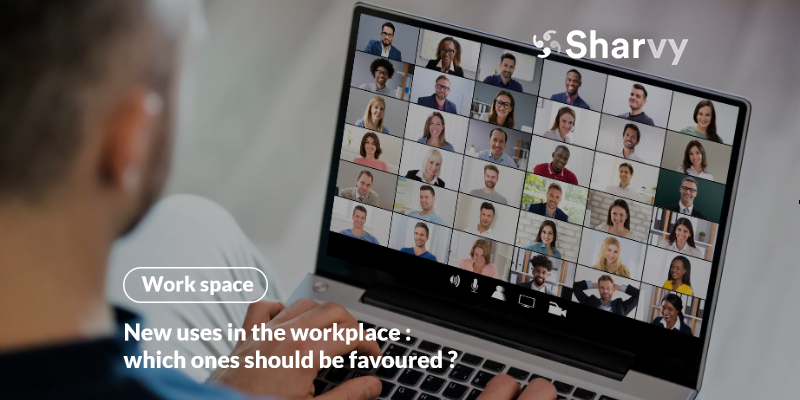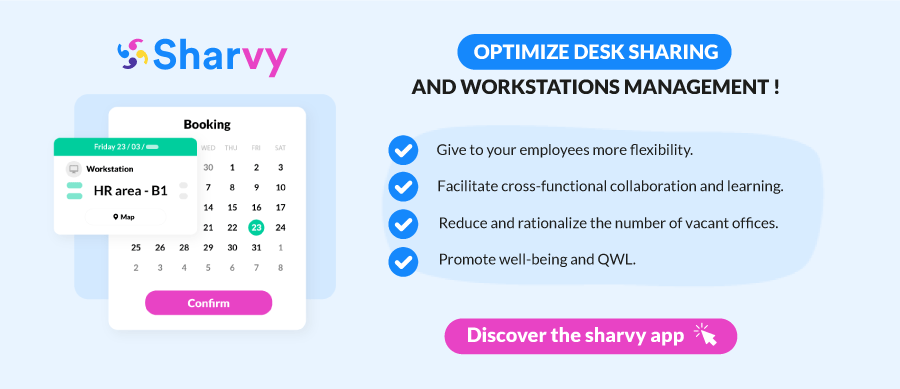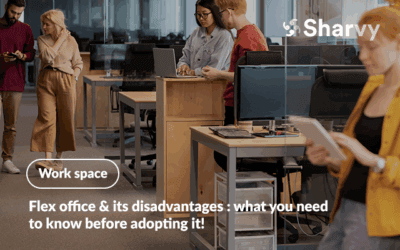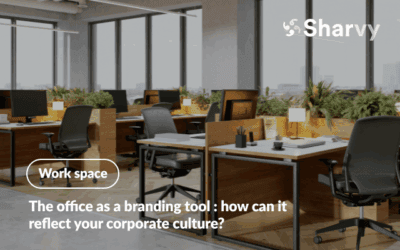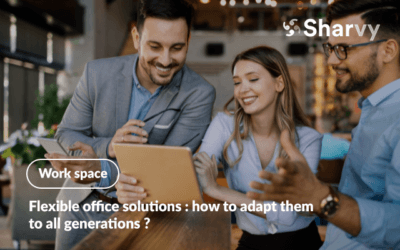There’s no doubt about it : the contours of the future of work are gradually taking shape. A paradigm shift that companies and employees are fully aware of!
Now, the shift to a more flexible working environment is underway, and companies need to embrace new ways of working. They must adapt to these new challenges to remain competitive and attract the best talent.
So, what will tomorrow’s professional landscape look like? Let’s take a look at five new and fast-growing ways of working.
New employee expectations that (above all) must not be ignored!
BNP Paribas Real Estate, has unveiled the results of a European survey, conducted with IFOP among 3,500 employees in 7 European countries, on their aspirations for the future of work. The study reveals that employees’ vision of the office and their expectations differ from the country. For example, it is worth noting that :
- 70% of employees in the UK believe that the office is still just a place to work, where you should spend as little time as possible – far ahead of the Germans (53%) and the Spanish (52%), who are also in the majority in this view.
- Conversely, more than one in two French people (51%) see the office as a place for social interaction, friendliness, and collaboration. This view is shared by 61% in the Netherlands and 56% in Belgium.
When it comes to space planning, employees generally aspire to a mix of socialization and concentration :
- Unsurprisingly, the UK, which sees the office as a workplace only, prefers individual spaces (53% vs. 43% for group workplaces).
- Spain prefers spaces encouraging teamwork (56% vs. 32% for individual spaces).
- The Netherlands appreciates both types of space (55% for individual spaces, 54% for group work), and even flex office (45%). In France, employees’ opinions are fairly divided between personal workspaces (46%) and collaborative workspaces (44%). However, 46% demand the presence of user-friendly areas (cafeteria, lounge, games room, etc.).
The bottom line is that we are at a tipping point regarding the working environment. Today, the quality of the spaces and services companies offer is essential in retaining employees and attracting new talent.
5 new and growing uses for our workplaces!
1. The flex office, a genuine accelerator of organizational change.
In recent years, hybrid working has become the norm, and we are seeing massive and uninhibited adoption of teleworking. What was once an emergency option has become, in the space of a few months, an appreciable convenience and now a requirement for many employees. So, there is no turning back.
This context is bringing companies to a new reality : the more ambitious the number of teleworking days, the less sense there is in maintaining one workstation per employee. Not least because employers are bitterly observing many vacant spaces for which they are paying a high price.
Faced with this phenomenon, companies need to reinvest more strategically. This is why the flex office (also known as the flex desk) is becoming increasingly popular. The reason is apparent : this practice goes hand in hand with hybrid work organization. It de-territorializes the workstation by decreeing that allocating a specific workstation to each employee no longer makes sense.
As a result, employees can choose where they work according to their needs, tasks, and objectives for the day. This is done without any hierarchical and/or corporatist concerns.
This way, the flex office aims to break down the sedentary lifestyle and create a new, friendlier, and more informal working environment. It’s a virtuous cross-fertilization, where teams from each division are encouraged to mix and bond.
Note that other anglicisms, such as desk sharing and hot desking, share the same characteristics as the flex office, with a few nuances.
✔ The flex office, for which needs?
On the one hand, the flex office meets a business need. The reality today is that when you walk around offices, ¾ of the time, you notice that they are empty! Companies, therefore, have a card to play here by optimizing their workspaces to reduce their property costs. Let’s not forget : these unoccupied spaces have a price, which flex office can absorb.
On the other hand, the flex office meets employees’ flexibility need. The flexibility provided by flex office allows employees to diversify their workplace, to work from more informal and user-friendly spaces: in other words, places where employees feel ‘at home’, such as reinvented offices.
Curious to find out how IRD met its needs through the flex office? Download the dedicated case study and learn more about their approach to improving Quality of Life at Work (QWL).
2. Activity-Based Working : each space, a given activity.
Originating in the Netherlands, Activity-Based Working (ABW) is a different way of thinking about work, involving a reorganization of space and time. In this type of organization, the company offers its employees a range of spaces to work.
The idea is to combine, in sufficient quantity : places to isolate oneself and encourage concentration, meeting rooms of all sizes – huddle room, meeting box, focus room, etc. – and areas for relaxing and enjoying a meal.
It should be noted that each of these areas has ergonomic furniture. In addition, particular attention is paid to the acoustics and luminosity of the spaces (Lightning design). Companies take the time to create different lighting moods with the right intensity for each space. This lighting detail not only reduces employee fatigue but also improves productivity!
✔ Activity-Based Working, for which needs?
This type of layout is becoming increasingly popular with companies looking to create unstructured teams and impromptu meetings. The movement induced by the ABW encourages staff to cross paths and exchange ideas. This creates a dynamic working environment and fosters synergies that improve agility, creativity, and productivity.
As a result, Activity-Based Working responds more to a need for optimization and the development of varied, evolving, and modular spaces.
3. Teleworking, a valuable card to play for companies.
The practice of teleworking is familiar (or 2020) ! However, before the Covid-19 crisis, teleworking remained marginal and was reserved for certain working people : generally the self-employed, freelance (the famous “Digital nomads“), or certain managers whose activity and schedule allowed them to organize their work flexibly.
But the Covid-19 pandemic has turned many aspects of our daily lives upside down, not least how we organize our work. While home-office working was just a simple ‘way of working’ at the time, it became a real lever for maintaining activity in the face of a global health crisis.
Today, according to a study conducted by IESE Business School and the consultancy Savills Aguirre Newman, teleworking is becoming a permanent fixture in companies at a rate of two days a week. There are many reasons for using this practice: reduced travel time, a better balance between employees’ professional and personal lives, extra sleep time, greater concentration, flexible hours for dropping children off at school, etc.
What’s more, it has become an apparent reflex in the event of snow, strikes, epidemic outbreaks, and/or, quite simply, fatigue. Doctors sometimes even recommend increasing an employee’s teleworking if they feel it’s necessary. This solution no longer shocks anyone and is becoming the new norm.
Finally, while teleworking implies adaptations in terms of management and organization, it should be noted that each company decides how it will operate. A teleworking charter is usually created to provide a framework for this practice and a standard frame of reference.
✔ Teleworking, for which needs?
In recent years, flexibility has become particularly popular for employees. So, companies have yet to find solutions to meet the new demands. For this, teleworking is a sensible way of meeting employees’ crying expectations!
At the same time, for employers and HR managers, teleworking has become a valuable card to play in attracting and retaining the Z and Y generations, who make teleworking a non-negligible criterion. As a result, it’s a safe bet that, for the same job and salary, candidates will prefer the company that offers greater flexibility and, therefore, the possibility of teleworking for a few days.
4. Corpoworking, a truly collaborative hub.
Far from being a fleeting phenomenon, coworking spaces are booming and, above all, in tune with changes in the world of work.
This concept transposes the codes of coworking to the corporate world. Created from the fusion of “Corporate” and “Working“, it is increasingly appealing to companies looking to rethink and reinvigorate their workspaces.
They are creating flexible, collaborative workspaces similar to coworking spaces on their premises. In this space, employees from the same company and people from outside the company work together. They may be self-employed, service providers, freelancers, or young start-ups.
Unlike coworking spaces, corpoworking spaces are not open to everyone. They are subject to authorization from the host company.
Today, with the spread of teleworking, there is an even greater desire among employees to find alternative workspaces. Flexible and stimulating, these spaces help erase the boundaries between a company’s businesses and encourage cross-functional collaboration and cooperation. At the same time, they bring together skills that were previously categorized within departments.
This, in turn, stimulates learning and the generation of ideas, which are highlighted in the events organized in the corpoworking space (workshops, debates, meetings, and co-lunches). These spaces are, therefore, an opportunity for employees to enrich their professional network.
✔ Corpoworking, for which needs?
Corpoworking meets two everyday needs of companies and employees.
For companies, the creation of such a space not only makes it possible to optimize and remodel unoccupied square meters by renting or lending them (as desired) to external entrepreneurs, freelancers, and start-ups in search of a spirit of sharing. However, this is also an opportunity for them to modernize and innovate. By taking this route, they improve their employer brand and show their employees that they understand the challenges of workspace management and flexible working. These spaces meet the needs of companies that want to accelerate their growth, develop a collective dynamic and create synergies between internal and external players.
For employees, corpoworking space recreates the feeling of belonging to a community. Particularly in the wake of health crises, which have distanced employees from one another. Corpoworking spaces ultimately act as rallying points for all talents, where synergies are created thanks to “corporate” events. These events, which employees appreciate, can be internal (such as breakfasts, co-lunches, workshops, etc) and external (round tables, conferences, etc). Finally, corpoworking spaces improve employees’ Quality of Life and Working Conditions (QLWC).
5. The smart office, an innovative and intelligent working environment.
Smart office is a workspace in which new technologies are used to serve the needs and well-being of employees. The aim is to enable employees to work in optimum conditions and improve their productivity.
Remember that employees waste precious time and energy on tasks and activities with no added value : looking for a parking space, finding a free workstation (particularly in large companies), queuing in the catering area, etc.
To meet these challenges, the smart office includes, for example :
- IoT equipment and technologies : smart, connected meeting rooms with cameras and click-and-play technology (so that your employees can easily share their content and/or presentations), videoconferencing software and tools (Zoom, Teams, Google Meet), digital voice assistants, intranet tools and internal social networks, and possibly service marketplaces for employees, etc.
- Intuitive web & mobile applications : making it easier to keep track of everyone’s diaries & reserve spaces (parking spaces, workstations, charging points, other resources, etc). Depending on the application chosen, it is also possible to monitor the occupancy rate of each space and the use of resources. The Sharvy application makes all this possible in just a few clicks!
- Artificial intelligence and process automation software : mainly to improve operational efficiency.
✔ The smart office, for which needs?
Companies can respond to today’s economic, environmental, and social needs by opting for the smart office.
For example, by controlling the heating, ventilation, and/or air conditioning according to the data collected and the occupancy rate, companies can optimize the energy consumption of their offices, reduce the amount of space occupied and cut the costs associated with maintaining the rooms. These factors enable companies to improve their buildings’ energy performance and make significant savings too!
What new uses should your company focus on?
As you can see, the design of workspaces should reflect the needs and activities of YOUR employees.
However, a trend is emerging within companies that meet the expectations of a wide range of employees. The idea is to reverse the relationship between individual and collective space.
Rather than traditionally devoting 70% of space to workstations and 30% to other functions, the aim now is to prioritize collaborative spaces. The square meters freed up in this way are often used for a social hub, a place to live and work informally, and a more comprehensive range of themed spaces (creative workshops, presentation areas, relaxation areas, catering areas, etc.).
Once this optimization has been achieved, the next step is to find the right balance between the layouts above informal and formal exchanges, professional and personal, relaxation, and concentration.
To determine which is best for your company, involve your teams in your project. So, listen to your employees to identify the working methods that suit your workforce, business categories, and objectives.
Also, bear in mind that it is possible to combine several new uses in your workplace.
For example, the flex office goes hand in hand with teleworking, and both can be perfectly combined with Activity-Based Working (ABW).
In the same way, corpoworking is interesting to propose with teleworking because you offer multi-purpose spaces that employees can use differently as they wish throughout the working day and/or week.
Do you need support in this process? Would you like to smoothly transition to a flex office, desk sharing, or hot desking? Contact a Sharvy expert for guidance and a customized solution for your company!
In conclusion
Undoubtedly, although it has lost its monopoly, the office is here to stay. In practical terms, it remains the first place capable of providing essential infrastructures that cannot be duplicated at home. It is also the primary spatial embodiment of the company, a place where knowledge, values, and a typical project are passed on!
However, in recent years, demands on the workspace have always remained the same. And with good reason: today’s employees are constantly moving from one activity to another in a day and are engaged in five different modes of work: concentration, socialization, collaboration, learning, and regeneration.
Of course, no one space (on its own) can meet all these needs, but each must be conducive to performance. That’s why companies now need to rethink their workspaces along these lines to meet the new expectations of their employees.
Have a question? Check the following FAQ!
Redesigning your workspace : what are the 4 essential steps to excellence?
There are several stages to a successful reorganization project.
First of all, listen to your employees. A company is not just its board of directors or its managers. A company is a whole comprised of people working towards the same goal. That’s why, when preparing a project to overhaul your workspaces, involving your employees from the start is essential. Ask them what they like about their offices, what they would like to see changed, the difficulties they encounter daily, etc.
Then, co-imagine the future of your offices with your employees. This can be done through working groups, brainstorming sessions, surveys, suggestion boxes, and test areas. At this stage, the whole point is for them to become players in the environment rather than spectators.
At the same time, enlist the help of experts to adapt the layout of your offices to the needs identified by the group.
Finally, gather everyone’s experiences so that you can make any necessary adjustments. A company project evolves: today’s workspaces are not necessarily tomorrow’s. You have to think of the project as a living object, let the workspaces live, and let the employees make them their own!
Is it possible to reinvent your workspaces while improving your CSR policy?
Of course, it is!
To guide you in your approach, in the light of your project to fit out and/or refurbish your offices, you first need to think in terms of “second life.” Ask yourself : Should all the furniture be replaced? Is it possible to keep certain items instead of scraping them? And so on.
At the same time, consider installing mainly LED panels in open spaces. The result: drastically reduced electricity consumption and a much longer lifespan. You should also install motion detectors in high-traffic areas, communal areas, washrooms, catering areas, etc. And remember to install water-saving devices on taps!
Similarly, if you are creating a cafeteria area, ban plastic. For example, by offering reusable glasses and water bottles bearing the company logo. Also, encourage sorting by making bins available. These are just a few examples, but there are plenty of ideas for improving your CSR policy at this stage in your company’s life.
How can you create a flexible work environment that is adapted to all employees?
Creating a flexible work environment involves a multifaceted approach. To start, it’s essential to design varied workspaces that meet the different work modes of employees. This includes individual desks for those who need concentration, collaborative workspaces to encourage team innovation, and coworking spaces or third places for nomadic workers or those seeking a more informal setting.
The flexibility of the spaces can be enhanced by using modular spaces that can be reconfigured according to current needs. For example, an open space can be subdivided into focus areas or shared desk spaces according to the requirements of ongoing projects.
Integrating technologies like a workplace management solution allows for effective management of the availability of shared desks and tracking of meeting room occupancy. Additionally, a particular focus should be placed on workplace well-being by creating pleasant and comfortable spaces, where employees feel at ease and motivated.
Finally, for a flexible work environment to be truly effective, it must be supported by a company culture that values flexibility and encourages autonomy, while providing a structured framework for collaboration times.
Want to learn more? Check out our latest articles!
Flex office & its disadvantages : what you need to know before adopting it!
What is the flex office? How does it work? What are its drawbacks and how can you overcome them? Find the answers in this article!
The office as a branding tool : how can it reflect your corporate culture?
Is the office an underestimated branding tool? How can your spaces embody your culture & reinforce your brand image? Focus!
Flexible office solutions : how to adapt them to all generations ?
How can flexible office solutions adapt to the needs of different generations? What are the best strategies to implement? Focus!
Subscribe to our newsletter!
Resources
Contact us
+44 117 463 6990

